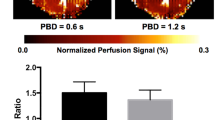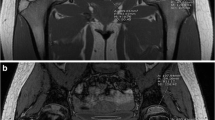Abstract
Hematopoietic bone marrow in the distal femur of the adult may be mistaken for a pathologic marrow process in magnetic resonance imaging of the knee. We investigated the incidence of hematopoietic marrow in the distal femur in a series of 51 adult patients and compared spin-echo (TR/TE in ms: 500/35, 2000/80) and opposed-phase gradient-echo (0.35 T, TR/TE in ms: 1000/30, θ = 75°) magnetic resonance images. Zones with intermediate to low signal intensity on T1-weighted spinecho and opposed-phase gradient-echo sequences representing hematopoietic marrow within high signal intensity fatty marrow were observed in 18 of the 51 patients. Five patterns of marrow signal reduction were identified; type 0: uniform high signal, i.e., no signal change; type I, focal signal loss; type II, multifocal signal loss without confluence; type III, confluent signal loss; and type IV, complete homogeneous reduction in marrow signal. Opposed-phase gradient-echo sequences demonstrated markedly greater red-yellow marrow contrast than conventional spin-echo sequences. Follow-up studies in three patients using a gradient-echo sequence with TE varying from 10 to 21 ms at 1-ms increments showed a cyclic increase and decrease in red and yellow marrow signal intensity depending on the TE. The contribution of intravoxel chemical shift effects on red-yellow marrow contrast in opposed-phase gradient-echo images was verified by almost complete cancellation of the TE-dependent marrow signal oscillation with use of a chemically selective pulse presaturating the water protons.
Hematopoietic marrow in the adult distal femur in the absence of hematologic abnormalities is found primarily in women of menstruating age. It may be residual and may represent a biologic variation in the normal adult pattern of red-yellow marrow distribution. Reconverted red marrow appears to be related to increased erythrocyte demand. Residual and reconverted red marrow should not be mistaken for bone marrow malignancy. Opposed-phase gradient-echo imaging is easily implemented and appears ideally suited to monitor the distribution of hematopoietic marrow as a function of age and erythrocyte demand in vivo.
Similar content being viewed by others
References
Dooms GC, Fisher MR, Hricak H, Richardson M, Crooks LE, Genant HK (1985) Bone marrow imaging: magnetic resonance studies related to age and sex. Radiology 155:429
Mitchell DG, Rao VM, Dalinka M, Spritzer CE, et al. (1986) Hematopoietic and fatty marrow distribution in the normal and ischemic hip: new observations with 1.5 T MR imaging. Radiology 161:199
Moore SG, Dawson KL (1990) Red and yellow marrow in the femur: age-related changes in appearance at MR imaging. Radiology 175:219
Okada Y, Aoki S, Barkovich AJ, Nishimura K, Norman D, Kjos BO, Brasch RC (1989) Cranial bone marrow in children: assessment of normal development with MR imaging. Radiology 171:161
Ricci C, Cova M, Kang YS, Yang A, et al. (1990) Normal age-related patterns of cellular and fatty bone marrow distribution in the axial skeleton: MR imaging study. Radiology 177:83
Richards T, Davis CA, Barker BR, Beinert B, Genant HK (1987) Lipid/water ratio of bone marrow measured by phaseencoded proton nuclear magnetic resonance spectroscopy. Investigat Radiol 22:741
Vogler JB, Murphy WA (1988) Bone marrow imaging. Radiology 168:679–693
Cohen MD, Klatte EC, Baehner RA, Smith JA, et al. (1984) Magnetic resonance imaging of bone marrow disease in children. Radiology 151:715
Daffner RH, Lupetin AR, Dash N, Deeb ZL, Sefczek RJ, Schapiro RL (1986) MRI in the detection of malignant infiltration of bone marrow. AJR 146:353
Kangarloo H, Dietrich RB, Taira R, Gold RH, Lenarsky C, Boechat MI, Feig SA, Salusky I (1986) MR imaging of bone marrow in children. J Comput Assist Tomogr 10:205
Lang P, Jergesen HE, Moseley ME, Block JE, Chafetz NI and Genant HK (1988) Avascular necrosis of the femoral head: high-field-strength MR imaging with histologic correlation. Radiology 169:517
Lang P, Jergesen HE, Genant HK, Moseley ME, Schulte-Monting J (1989) Magnetic resonance imaging of the ischemic femoral head in pigs: dependency of signal intensities and relaxation times on elapsed time. Clin Orthop 244:272
Shields AF, Porter BA, Churchley S, Olson DA, Appelbaum FR, Thomas ED (1987) The detection of bone marrow involvement by lymphoma using magnetic resonance imaging. J Clin Oncol 5:225
Stevens SK, Moore SG, Kaplan ID (1990) Early and late bone marrow changes after irradiation: MR evaluation. AJR 154:745
Kricun ME (1985) Red-yellow marrow conversion: its effect on the location of some solitary bone lesions. Skeletal Radiology 14:10
Deutsch AL, Mink JH, Rosenfelt FP, Waxman AD (1989) Incidental detection of hematopoietic hyperplasia on routine knee MR imaging. AJR 152:333
Shellock FG, Morris E, Deutsch AL, Mink JH, Kerr R, Boden SD (1992) Hematopoietic bone marrow hyperplasia: high prevalence on MR images of the knee in asymptomatic marathon runners. AJR 158:335
Dixon WT (1984) Simple proton spectroscopic imaging. Radiology 153:189–194
Wismer GL, Rosen BR, Buxton R, Stark DD, Brady TJ (1985) Chemical shift imaging of bone marrow: preliminary experience. AJR 145:1031
Custer RP (1932) Studies on the structure and function of bone marrow. I. Variability of the hematopoietic pattern and consideration of method for examination. J Lab Clin Med 17:951
Hashimoto M (1962) Pathology of bone marrow. Acta Haematol (Basel) 27:193–216
Weiss L (1967) The histophysiology of bone marrow. Clin Orthop 52:13
Piney A (1922) The anatomy of the bone marrow. With special reference to the distribution of the red marrow. BJM 792
Zimmer WD, Berquist TH, McLeod RA, Sim FH, Pritchard DJ, Shives TC, Wold LE, May GR (1985) Bone tumors: magnetic resonance imaging versus computed tomography. Radiology 155:709
Snyder WS, Cook MJ, Nasset ES, Karhausen LR, Howells GP, Tipton IH (1975) Report of the task group on reference man
Gomori JM, Grossman RI, Goldberg HI, Zimmerman RA, Bilaniuk LT (1985) Intracranial hematomas: imaging by high-field MR. Radiology 157:87
Author information
Authors and Affiliations
Rights and permissions
About this article
Cite this article
Lang, P., Fritz, R., Majumdar, S. et al. Hematopoietic bone marrow in the adult knee: spin-echo and opposed-phase gradient-echo MR imaging. Skeletal Radiol. 22, 95–103 (1993). https://doi.org/10.1007/BF00197984
Issue Date:
DOI: https://doi.org/10.1007/BF00197984




